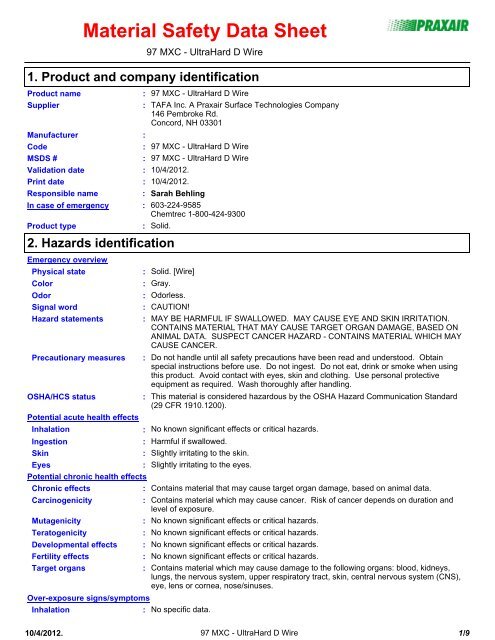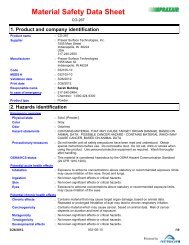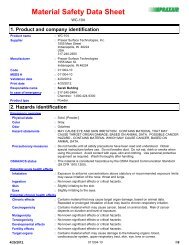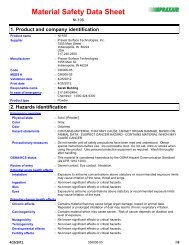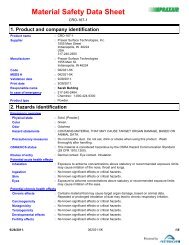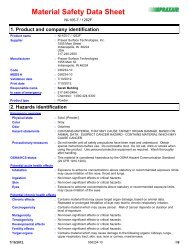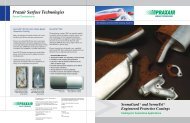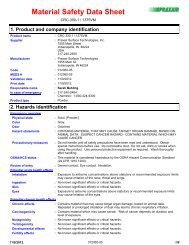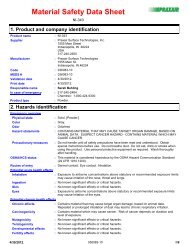97 MXC - Praxair Surface Technologies
97 MXC - Praxair Surface Technologies
97 MXC - Praxair Surface Technologies
Create successful ePaper yourself
Turn your PDF publications into a flip-book with our unique Google optimized e-Paper software.
Product name<br />
Supplier<br />
Manufacturer<br />
Code<br />
MSDS #<br />
Validation date<br />
Print date<br />
Material Safety Data Sheet<br />
<strong>97</strong> <strong>MXC</strong> - UltraHard D Wire<br />
1. Product and company identification<br />
Responsible name<br />
In case of emergency<br />
Product type<br />
2. Hazards identification<br />
Emergency overview<br />
Physical state<br />
Color<br />
Potential acute health effects<br />
Inhalation<br />
:<br />
Ingestion<br />
:<br />
Skin<br />
:<br />
Eyes<br />
:<br />
Potential chronic health effects<br />
:<br />
:<br />
<strong>97</strong> <strong>MXC</strong> - UltraHard D Wire<br />
TAFA Inc. A <strong>Praxair</strong> <strong>Surface</strong> <strong>Technologies</strong> Company<br />
146 Pembroke Rd.<br />
Concord, NH 03301<br />
:<br />
: <strong>97</strong> <strong>MXC</strong> - UltraHard D Wire<br />
: <strong>97</strong> <strong>MXC</strong> - UltraHard D Wire<br />
: 10/4/2012.<br />
: 10/4/2012.<br />
: Sarah Behling<br />
: 603-224-9585<br />
Chemtrec 1-800-424-9300<br />
: Solid.<br />
:<br />
Solid. [Wire]<br />
Odor<br />
: Odorless.<br />
Signal word<br />
: CAUTION!<br />
Hazard statements : MAY BE HARMFUL IF SWALLOWED. MAY CAUSE EYE AND SKIN IRRITATION.<br />
CONTAINS MATERIAL THAT MAY CAUSE TARGET ORGAN DAMAGE, BASED ON<br />
ANIMAL DATA. SUSPECT CANCER HAZARD - CONTAINS MATERIAL WHICH MAY<br />
CAUSE CANCER.<br />
Precautionary measures<br />
OSHA/HCS status<br />
Chronic effects<br />
Carcinogenicity<br />
Mutagenicity<br />
Teratogenicity<br />
Developmental effects<br />
Fertility effects<br />
Target organs<br />
Over-exposure signs/symptoms<br />
Inhalation<br />
: Gray.<br />
: Do not handle until all safety precautions have been read and understood. Obtain<br />
special instructions before use. Do not ingest. Do not eat, drink or smoke when using<br />
this product. Avoid contact with eyes, skin and clothing. Use personal protective<br />
equipment as required. Wash thoroughly after handling.<br />
: This material is considered hazardous by the OSHA Hazard Communication Standard<br />
(29 CFR 1910.1200).<br />
No known significant effects or critical hazards.<br />
Harmful if swallowed.<br />
Slightly irritating to the skin.<br />
Slightly irritating to the eyes.<br />
: Contains material that may cause target organ damage, based on animal data.<br />
: Contains material which may cause cancer. Risk of cancer depends on duration and<br />
level of exposure.<br />
: No known significant effects or critical hazards.<br />
: No known significant effects or critical hazards.<br />
: No known significant effects or critical hazards.<br />
: No known significant effects or critical hazards.<br />
: Contains material which may cause damage to the following organs: blood, kidneys,<br />
lungs, the nervous system, upper respiratory tract, skin, central nervous system (CNS),<br />
eye, lens or cornea, nose/sinuses.<br />
: No specific data.<br />
10/4/2012.<br />
<strong>97</strong> <strong>MXC</strong> - UltraHard D Wire<br />
1/9
<strong>97</strong> <strong>MXC</strong> - UltraHard D Wire<br />
2. Hazards identification<br />
Ingestion<br />
Skin<br />
Eyes<br />
Medical conditions<br />
aggravated by overexposure<br />
See toxicological information (Section 11)<br />
: No specific data.<br />
: Adverse symptoms may include the following:<br />
irritation<br />
redness<br />
: Adverse symptoms may include the following:<br />
irritation<br />
watering<br />
redness<br />
:<br />
Pre-existing disorders involving any target organs mentioned in this MSDS as being at<br />
risk may be aggravated by over-exposure to this product.<br />
3. Composition/information on ingredients<br />
Name CAS number %<br />
Nickel 7440-02-0 1 - 5<br />
Iron 7439-89-6 20 - 50<br />
Manganese 7439-96-5 1 - 5<br />
Chromium 7440-47-3 5 - 20<br />
Silicon 7440-21-3 1 - 5<br />
Copper 7440-50-8
<strong>97</strong> <strong>MXC</strong> - UltraHard D Wire<br />
5. Fire-fighting measures<br />
Flammability of the product :<br />
Extinguishing media<br />
Suitable :<br />
Not suitable :<br />
Special exposure hazards :<br />
Hazardous thermal<br />
decomposition products<br />
Special protective<br />
equipment for fire-fighters<br />
:<br />
No specific fire or explosion hazard.<br />
6. Accidental release measures<br />
Personal precautions :<br />
Environmental precautions<br />
Methods for cleaning up<br />
Small spill :<br />
Large spill :<br />
7. Handling and storage<br />
Use an extinguishing agent suitable for the surrounding fire.<br />
None known.<br />
Promptly isolate the scene by removing all persons from the vicinity of the incident if<br />
there is a fire. No action shall be taken involving any personal risk or without suitable<br />
training.<br />
: Decomposition products may include the following materials:<br />
carbon dioxide<br />
carbon monoxide<br />
metal oxide/oxides<br />
Fire-fighters should wear appropriate protective equipment and self-contained breathing<br />
apparatus (SCBA) with a full face-piece operated in positive pressure mode.<br />
No action shall be taken involving any personal risk or without suitable training.<br />
Evacuate surrounding areas. Keep unnecessary and unprotected personnel from<br />
entering. Do not touch or walk through spilled material. Provide adequate ventilation.<br />
Wear appropriate respirator when ventilation is inadequate. Put on appropriate personal<br />
protective equipment (see Section 8).<br />
: Avoid dispersal of spilled material and runoff and contact with soil, waterways, drains<br />
and sewers. Inform the relevant authorities if the product has caused environmental<br />
pollution (sewers, waterways, soil or air).<br />
Move containers from spill area. Vacuum or sweep up material and place in a<br />
designated, labeled waste container. Dispose of via a licensed waste disposal<br />
contractor.<br />
Move containers from spill area. Approach release from upwind. Prevent entry into<br />
sewers, water courses, basements or confined areas. Vacuum or sweep up material<br />
and place in a designated, labeled waste container. Dispose of via a licensed waste<br />
disposal contractor. Note: see section 1 for emergency contact information and section<br />
13 for waste disposal.<br />
Handling<br />
Storage<br />
:<br />
:<br />
Put on appropriate personal protective equipment (see Section 8). Eating, drinking and<br />
smoking should be prohibited in areas where this material is handled, stored and<br />
processed. Workers should wash hands and face before eating, drinking and smoking.<br />
Remove contaminated clothing and protective equipment before entering eating areas.<br />
Avoid exposure - obtain special instructions before use. Do not get in eyes or on skin or<br />
clothing. Do not ingest. If during normal use the material presents a respiratory hazard,<br />
use only with adequate ventilation or wear appropriate respirator. Keep in the original<br />
container or an approved alternative made from a compatible material, kept tightly<br />
closed when not in use. Empty containers retain product residue and can be hazardous.<br />
Do not reuse container.<br />
Store in accordance with local regulations. Store in original container protected from<br />
direct sunlight in a dry, cool and well-ventilated area, away from incompatible materials<br />
(see section 10) and food and drink. Keep container tightly closed and sealed until ready<br />
for use. Containers that have been opened must be carefully resealed and kept upright<br />
to prevent leakage. Do not store in unlabeled containers. Use appropriate containment<br />
to avoid environmental contamination.<br />
10/4/2012.<br />
<strong>97</strong> <strong>MXC</strong> - UltraHard D Wire<br />
3/9
<strong>97</strong> <strong>MXC</strong> - UltraHard D Wire<br />
8. Exposure controls/personal protection<br />
Ingredient<br />
Exposure limits<br />
Tungsten Carbide ACGIH TLV (United States, 2/2010).<br />
TWA: 5 mg/m³, (as W) 8 hour(s). Form: Insoluble<br />
STEL: 10 mg/m³, (as W) 15 minute(s). Form: Insoluble<br />
NIOSH REL (United States, 6/2009).<br />
TWA: 5 mg/m³, (as W) 10 hour(s).<br />
STEL: 10 mg/m³, (as W) 15 minute(s).<br />
OSHA PEL 1989 (United States, 3/1989).<br />
TWA: 5 mg/m³, (as W) 8 hour(s). Form: Insoluble<br />
STEL: 10 mg/m³, (as W) 15 minute(s). Form: Insoluble<br />
Chromium<br />
ACGIH TLV (United States, 2/2010). Notes: measured as Cr<br />
TWA: 0.5 mg/m³, (measured as Cr) 8 hour(s). Form: Inorganic<br />
NIOSH REL (United States, 6/2009). Notes: See Appendix C -<br />
Supplemental Exposure Limits<br />
TWA: 0.5 mg/m³ 10 hour(s).<br />
OSHA PEL (United States, 6/2010). Notes: as Cr<br />
TWA: 1 mg/m³, (as Cr) 8 hour(s).<br />
OSHA PEL 1989 (United States, 3/1989).<br />
TWA: 1 mg/m³ 8 hour(s).<br />
Nickel ACGIH TLV (United States, 2/2010). Notes: Refers to Appendix A --<br />
Carcinogens. Inhalable fraction. See Appendix C, paragraph A.<br />
Inhalable Particulate Mass TLVs (IPM–TLVs) for those materials<br />
that are hazardous when deposited anywhere in the respiratory<br />
tract. 1998 Adoption.<br />
TWA: 1.5 mg/m³ 8 hour(s). Form: Inhalable fraction<br />
NIOSH REL (United States, 6/2009). Notes: as Ni<br />
TWA: 0.015 mg/m³, (as Ni) 10 hour(s).<br />
OSHA PEL (United States, 6/2010). Notes: as Ni<br />
TWA: 1 mg/m³, (as Ni) 8 hour(s).<br />
OSHA PEL 1989 (United States, 3/1989). Notes: as Ni<br />
TWA: 1 mg/m³, (as Ni) 8 hour(s).<br />
Manganese<br />
OSHA PEL (United States, 6/2010). Notes: as Mn<br />
CEIL: 5 mg/m³, (as Mn) Form: Fume<br />
OSHA PEL 1989 (United States, 3/1989). Notes: as Mn<br />
STEL: 3 mg/m³, (as Mn) 15 minute(s). Form: Fume<br />
TWA: 1 mg/m³, (as Mn) 8 hour(s). Form: Fume<br />
ACGIH TLV (United States, 2/2010). Notes: as Mn<br />
TWA: 0.2 mg/m³, (as Mn) 8 hour(s).<br />
Silicon OSHA PEL (United States, 6/2010).<br />
TWA: 5 mg/m³ 8 hour(s). Form: Respirable fraction<br />
TWA: 15 mg/m³ 8 hour(s). Form: Total dust<br />
OSHA PEL 1989 (United States, 3/1989).<br />
TWA: 5 mg/m³ 8 hour(s). Form: Respirable fraction<br />
TWA: 10 mg/m³ 8 hour(s). Form: Total dust<br />
NIOSH REL (United States, 6/2009).<br />
TWA: 10 mg/m³ 10 hour(s). Form: Total<br />
Recommended monitoring<br />
procedures<br />
Engineering measures<br />
Hygiene measures<br />
Personal protection<br />
: If this product contains ingredients with exposure limits, personal, workplace atmosphere<br />
or biological monitoring may be required to determine the effectiveness of the ventilation<br />
or other control measures and/or the necessity to use respiratory protective equipment.<br />
: If user operations generate dust, fumes, gas, vapor or mist, use process enclosures,<br />
local exhaust ventilation or other engineering controls to keep worker exposure to<br />
airborne contaminants below any recommended or statutory limits.<br />
: Wash hands, forearms and face thoroughly after handling chemical products, before<br />
eating, smoking and using the lavatory and at the end of the working period. Appropriate<br />
techniques should be used to remove potentially contaminated clothing. Wash<br />
contaminated clothing before reusing. Ensure that eyewash stations and safety showers<br />
are close to the workstation location.<br />
10/4/2012.<br />
<strong>97</strong> <strong>MXC</strong> - UltraHard D Wire<br />
4/9
<strong>97</strong> <strong>MXC</strong> - UltraHard D Wire<br />
8. Exposure controls/personal protection<br />
Respiratory<br />
Hands :<br />
Eyes<br />
Skin<br />
Environmental exposure<br />
controls<br />
9. Physical and chemical properties<br />
Physical state<br />
:<br />
Color<br />
:<br />
Odor<br />
:<br />
VOC content :<br />
Solubility<br />
:<br />
:<br />
:<br />
Use a properly fitted, air-purifying or air-fed respirator complying with an approved<br />
standard if a risk assessment indicates this is necessary. Respirator selection must be<br />
based on known or anticipated exposure levels, the hazards of the product and the safe<br />
working limits of the selected respirator.<br />
Chemical-resistant, impervious gloves complying with an approved standard should be<br />
worn at all times when handling chemical products.<br />
Safety eyewear complying with an approved standard should be used when a risk<br />
assessment indicates this is necessary to avoid exposure to liquid splashes, mists or<br />
dusts.<br />
Personal protective equipment for the body should be selected based on the task being<br />
performed and the risks involved and should be approved by a specialist before handling<br />
this product.<br />
: Emissions from ventilation or work process equipment should be checked to ensure they<br />
comply with the requirements of environmental protection legislation. In some cases,<br />
fume scrubbers, filters or engineering modifications to the process equipment will be<br />
necessary to reduce emissions to acceptable levels.<br />
:<br />
Solid. [Wire]<br />
Gray.<br />
Odorless.<br />
0 lbs/gal (0 g/l)<br />
10. Stability and reactivity<br />
Chemical stability<br />
Conditions to avoid<br />
Incompatible materials<br />
Hazardous decomposition<br />
products<br />
Possibility of hazardous<br />
reactions<br />
11. Toxicological information<br />
Acute toxicity<br />
Insoluble in the following materials: cold water and hot water.<br />
: The product is stable.<br />
: No specific data.<br />
: No specific data.<br />
: Under normal conditions of storage and use, hazardous decomposition products should<br />
not be produced.<br />
: Under normal conditions of storage and use, hazardous reactions will not occur.<br />
Product/ingredient name Result Species Dose Exposure<br />
Manganese LD50 Oral Rat 9 g/kg -<br />
Silicon LD50 Oral Rat 3160 mg/kg -<br />
Boron LD50 Oral Rat 650 mg/kg -<br />
Conclusion/Summary<br />
Chronic toxicity<br />
Conclusion/Summary<br />
Irritation/Corrosion<br />
: Not available.<br />
: Not available.<br />
Product/ingredient name Result Species Score Exposure Observation<br />
Manganese Eyes - Mild irritant Rabbit - 24 hours 500 -<br />
milligrams<br />
Skin - Mild irritant Rabbit - 24 hours 500 -<br />
milligrams<br />
Silicon Eyes - Mild irritant Rabbit - 3 milligrams -<br />
Conclusion/Summary<br />
Sensitizer<br />
: Not available.<br />
10/4/2012.<br />
<strong>97</strong> <strong>MXC</strong> - UltraHard D Wire<br />
5/9
<strong>97</strong> <strong>MXC</strong> - UltraHard D Wire<br />
11. Toxicological information<br />
Conclusion/Summary<br />
Carcinogenicity<br />
Conclusion/Summary<br />
Classification<br />
Mutagenicity<br />
Conclusion/Summary<br />
Teratogenicity<br />
Conclusion/Summary<br />
Reproductive toxicity<br />
Conclusion/Summary<br />
: Not available.<br />
: Not available.<br />
Product/ingredient name ACGIH IARC EPA NIOSH NTP<br />
Chromium A4 3 - - - -<br />
Nickel A5 2B - + Possible -<br />
: Not available.<br />
: Not available.<br />
: Not available.<br />
12. Ecological information<br />
Ecotoxicity<br />
Aquatic ecotoxicity<br />
: No known significant effects or critical hazards.<br />
OSHA<br />
Product/ingredient name Result<br />
Species<br />
Exposure<br />
Chromium Acute EC50 17.8 mg/L Marine water Algae - Dunaliella tertiolecta - 72 hours<br />
Exponential growth phase<br />
Acute EC50 5 ppm Marine water Aquatic plants - Macrocystis 4 days<br />
pyrifera - Young<br />
Acute LC50 87.5 ppm Marine water Crustaceans - Scylla serrata - 48 hours<br />
Intermolt - 9 cm - 95 g<br />
Acute LC50 14.3 ppm Fresh water Fish - Cyprinus carpio 96 hours<br />
Nickel Acute EC50 450 ug/L Fresh water Aquatic plants - Lemna minor 4 days<br />
Acute EC50 1000 ug/L Marine water Daphnia - Daphnia magna -
<strong>97</strong> <strong>MXC</strong> - UltraHard D Wire<br />
13. Disposal considerations<br />
Disposal should be in accordance with applicable regional, national and local laws and regulations.<br />
Refer to Section 7: HANDLING AND STORAGE and Section 8: EXPOSURE CONTROLS/PERSONAL PROTECTION<br />
for additional handling information and protection of employees.<br />
14. Transport information<br />
Regulatory<br />
information<br />
DOT Classification<br />
UN number<br />
Not<br />
regulated.<br />
Proper shipping<br />
name<br />
- - -<br />
-<br />
TDG Classification Not<br />
- -<br />
-<br />
regulated.<br />
Mexico<br />
Classification<br />
Not<br />
regulated.<br />
ADR/RID Class Not<br />
- - -<br />
regulated.<br />
IMDG Class Not<br />
- - -<br />
regulated.<br />
IATA-DGR Class Not<br />
regulated.<br />
-<br />
-<br />
-<br />
PG* : Packing group<br />
15. Regulatory information<br />
HCS Classification<br />
U.S. Federal regulations<br />
:<br />
:<br />
Classes PG* Label Additional<br />
information<br />
- - - -<br />
Carcinogen<br />
Target organ effects<br />
TSCA 8(a) IUR Exempt/Partial exemption: Not determined<br />
United States inventory (TSCA 8b): All components are listed or exempted.<br />
SARA 302/304/311/312 extremely hazardous substances: No products were found.<br />
SARA 302/304 emergency planning and notification: No products were found.<br />
SARA 302/304/311/312 hazardous chemicals: Nickel; Manganese; Silicon<br />
SARA 311/312 MSDS distribution - chemical inventory - hazard identification:<br />
Nickel: Fire hazard, Immediate (acute) health hazard, Delayed (chronic) health hazard;<br />
Iron: Fire hazard; Manganese: reactive, Immediate (acute) health hazard, Delayed<br />
(chronic) health hazard; Silicon: Fire hazard, Immediate (acute) health hazard<br />
Clean Water Act (CWA) 307: Chromium; Nickel; Copper<br />
-<br />
-<br />
-<br />
-<br />
Clean Air Act Section<br />
112(b) Hazardous Air<br />
Pollutants (HAPs)<br />
Clean Air Act Section 602<br />
Class I Substances<br />
Clean Air Act Section 602<br />
Class II Substances<br />
DEA List I Chemicals<br />
(Precursor Chemicals)<br />
DEA List II Chemicals<br />
(Essential Chemicals)<br />
SARA 313<br />
: Not listed<br />
: Not listed<br />
: Not listed<br />
: Not listed<br />
: Not listed<br />
10/4/2012.<br />
<strong>97</strong> <strong>MXC</strong> - UltraHard D Wire<br />
7/9
<strong>97</strong> <strong>MXC</strong> - UltraHard D Wire<br />
15. Regulatory information<br />
Form R - Reporting<br />
requirements<br />
Supplier notification<br />
Massachusetts<br />
: The following components are listed: CHROMIUM; NICKEL; MANGANESE; SILICON<br />
DUST<br />
: The following components are listed: Chromium; Nickel<br />
: The following components are listed: TUNGSTEN CARBIDE; CHROMIUM; NICKEL;<br />
MANGANESE; SILICON; BORON<br />
: The following components are listed: CHROMIUM; NICKEL; MANGANESE; SILICON<br />
WARNING: This product contains a chemical known to the State of California to cause cancer.<br />
International regulations<br />
International lists :<br />
Product name CAS number Concentration<br />
Chromium 7440-47-3 5 - 20<br />
Nickel 7440-02-0 1 - 5<br />
Manganese 7439-96-5 1 - 5<br />
Chromium 7440-47-3 5 - 20<br />
Nickel 7440-02-0 1 - 5<br />
Manganese 7439-96-5 1 - 5<br />
SARA 313 notifications must not be detached from the MSDS and any copying and redistribution of the MSDS shall<br />
include copying and redistribution of the notice attached to copies of the MSDS subsequently redistributed.<br />
State regulations<br />
New York<br />
New Jersey<br />
Pennsylvania<br />
California Prop. 65<br />
Ingredient name Cancer Reproductive No significant risk<br />
level<br />
Nickel Yes. No. No. No.<br />
Canada inventory<br />
Chemical Weapons<br />
Convention List Schedule I<br />
Chemicals<br />
Chemical Weapons<br />
Convention List Schedule<br />
II Chemicals<br />
Chemical Weapons<br />
Convention List Schedule<br />
III Chemicals<br />
16. Other information<br />
: All components are listed or exempted.<br />
Maximum<br />
acceptable dosage<br />
level<br />
Australia inventory (AICS): Not determined.<br />
China inventory (IECSC): All components are listed or exempted.<br />
Japan inventory: Not determined.<br />
Korea inventory: All components are listed or exempted.<br />
New Zealand Inventory of Chemicals (NZIoC): All components are listed or exempted.<br />
Philippines inventory (PICCS): Not determined.<br />
: Not listed<br />
: Not listed<br />
: Not listed<br />
Label requirements :<br />
Hazardous Material<br />
Information System (U.S.A.)<br />
:<br />
MAY BE HARMFUL IF SWALLOWED. MAY CAUSE EYE AND SKIN IRRITATION.<br />
CONTAINS MATERIAL THAT MAY CAUSE TARGET ORGAN DAMAGE, BASED ON<br />
ANIMAL DATA. SUSPECT CANCER HAZARD - CONTAINS MATERIAL WHICH MAY<br />
CAUSE CANCER.<br />
Health<br />
Flammability<br />
Physical hazards<br />
0<br />
1<br />
0<br />
10/4/2012.<br />
<strong>97</strong> <strong>MXC</strong> - UltraHard D Wire<br />
8/9
<strong>97</strong> <strong>MXC</strong> - UltraHard D Wire<br />
16. Other information<br />
Caution: HMIS® ratings are based on a 0-4 rating scale, with 0 representing minimal hazards or risks, and 4<br />
representing significant hazards or risks Although HMIS® ratings are not required on MSDSs under 29 CFR<br />
1910.1200, the preparer may choose to provide them. HMIS® ratings are to be used with a fully implemented<br />
HMIS® program. HMIS® is a registered mark of the National Paint & Coatings Association (NPCA). HMIS®<br />
materials may be purchased exclusively from J. J. Keller (800) 327-6868.<br />
The customer is responsible for determining the PPE code for this material.<br />
National Fire Protection<br />
Association (U.S.A.)<br />
:<br />
Health<br />
0<br />
1<br />
0<br />
Flammability<br />
Instability/Reactivity<br />
Special<br />
Reprinted with permission from NFPA 704-2001, Identification of the Hazards of Materials for Emergency<br />
Response Copyright ©19<strong>97</strong>, National Fire Protection Association, Quincy, MA 02269. This reprinted material is not<br />
the complete and official position of the National Fire Protection Association, on the referenced subject which is<br />
represented only by the standard in its entirety.<br />
Copyright ©2001, National Fire Protection Association, Quincy, MA 02269. This warning system is intended to be<br />
interpreted and applied only by properly trained individuals to identify fire, health and reactivity hazards of<br />
chemicals. The user is referred to certain limited number of chemicals with recommended classifications in NFPA<br />
49 and NFPA 325, which would be used as a guideline only. Whether the chemicals are classified by NFPA or not,<br />
anyone using the 704 systems to classify chemicals does so at their own risk.<br />
Date of printing<br />
Date of issue<br />
Date of previous issue<br />
Version<br />
Prepared by<br />
: 10/4/2012.<br />
: 10/4/2012.<br />
: No previous validation.<br />
: 1<br />
: Not available.<br />
Indicates information that has changed from previously issued version.<br />
Notice to reader<br />
To the best of our knowledge, the information contained herein is accurate. However, neither the above-named<br />
supplier, nor any of its subsidiaries, assumes any liability whatsoever for the accuracy or completeness of the<br />
information contained herein.<br />
Final determination of suitability of any material is the sole responsibility of the user. All materials may present<br />
unknown hazards and should be used with caution. Although certain hazards are described herein, we cannot<br />
guarantee that these are the only hazards that exist.<br />
10/4/2012.<br />
<strong>97</strong> <strong>MXC</strong> - UltraHard D Wire<br />
9/9


